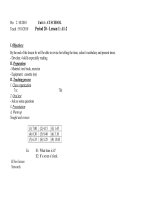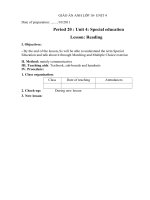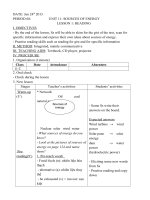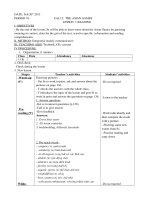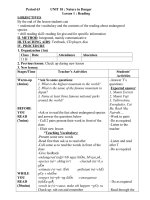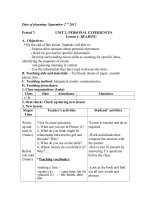GIÁO án ANH lớp 10 unit 4
Bạn đang xem bản rút gọn của tài liệu. Xem và tải ngay bản đầy đủ của tài liệu tại đây (118.38 KB, 11 trang )
GIÁO ÁN ANH LỚP 10- UNIT 4
Date of preparation: /10/2011
Period 20 : Unit 4: Special education
Lesson: Reading
I. Objectives:
- By the end of the lesson, Ss will be able to understand the term Special
Education and talk about it through Matching and Multiple Choice exercise
II. Method: mainly communicative
III. Teaching aids: Textbook, sub-boards and handouts
IV. Procedure:
1. Class organization:
Class Date of teaching Attendances
2. Check-up: During new lesson
3. New lesson:
Stage Teacher’s activities Students’ activities
Warm up
Before
reading
While
reading
- Greeting
- Who’s absent today?-
Thanks
- Where did you stop last
time?
- Open your book and we will
go to Unit 4: Special
Education
+ Ask Ss to answer the
questions:
* What do you do everyday?
* Do you go to class? listen to
music? watch T.V?
- Take notes students’ answers
on the blackboard
* Which of these activities
would be difficult for disabled
people?
Ok, people who cannot be
able to listen and watch are
called deaf and blind people.
* Who can say nothing?-
Good
* How can they
communicative with each
other?
* How can blind people read?
Well, there was a person- a
man invented the letter
systems for blind people to
help them read easily. He was
Louise Braille. He came from
France. He was a blinded in a
chilhood accident.
- Look at Braille Alphabet (on
the page 44) and work with
your partner about the
message
1. Task 1
- Ask students to read through
the passage individually and
do Task 1
- Raising some questions
about the passage:
* Who’s in the passage?
* What does the passage talk
about?
* How many children are
there in her class?
- Greeting
- The monitor answers
- Answer in chorus
- Open the books and listen to
the teacher
- Answer freely
- Listen to the teacher
- dumb people
- use signals
- We don’t know (maybe
students answer by
Vietnamese)
- Listen to the teacher
- Look at the books
- Work in pairs
- After guessing, correct the
answer under the teacher’s
construction
- Give answers:
A. we
B. are
C. the
D. world
- Read individually
- Miss Thuy
- special class
- 25
- disable people
- No, they don’t
4. Consolidation: summarize the main points of the lesson
5. Homework: ask Ss to learn the new words by heart, read and translate the
text and prepare the next period
Date of preparation /10/2011
Period 21: Unit 4: Special education
Lesson: Speaking
I. Objectives:
By the end of the lesson the students will be able to :
- talk about school life of a student
- actively engage in an interview
II. Method: mainly communicative
III. Teaching aids: Textbook, lesson planning
IV. Procedure:
1. Class organization:
Class Date of teaching Attendances
2. Check-up: Check Ss’ homework
3. New lesson:
Stage Teacher’s activities Students’ activities
Warm up
Before
speaking
While
speaking
After
- How are you today?
- Are you ready for new
lesson
- Give hand-outs to review the
names of subjects at school
-Ask students to work in pairs
- Give answers:
- Ask some questions:
* What are your favourite
subjects?
* How much time do you
prepare for your lesson
everyday?
1. Task 1
- Ask students to read the
answer before choosing the
best questions
- Ask students to work in pairs
to fill in the blanks with the
right questions
- Call on some students to
explain their answers
- Give correct answers
- Call some pairs to read the
completed conversation
- Check pronunciation
2. Task 2
- Ask students to use his/her
own information to answer the
questions
- Instruct students to do this
task by using following
information
Hand-outs
- Ask students to work in pairs
with 3 students using the
questions in Task 1
- Help students use some
questions related to words,
such as:
What subjects were you good/
bad at?
How much homework did you
have to do?
- Check whether students can
make questions or not by
giving the previous words and
let students to make questions
using those words
- Go arround and provide help
if necessary
- Answer freely
Do the exercise in hand-out
- Work in pairs
- Correct the answers
Keys: 1.C-2.D-3.G-4.F-5.B-6.I
-7.E-8.A-9.H
- Answer freely
- Listen to the teacher
- Read the answers and do the
task 1
- Work in pairs
- Listen to their friends
- Listen to the teacher
attentively then correct the
answers
Keys: A.4-B.1-C.2-D.6-E.3-
F.5-G.7
- Listen to the teacher
- Work in pairs and do the task
2 under the construction of the
teacher
- Practice speaking in pairs
4. Consolidation: - Retell the main ideas of the lesson.
5. Homework:
- Ask students to write a short paragraph about his/her studying at
school (80-100 words)
Date of preparation /10/2011
Period 22: Unit 4: Special education
Lesson: Listening
I. Objectives:
Students will be able to listen better through True of False Statements and
Gap-filling exercises
II. Method: mainly communicative
III. Teaching aids: Textbook, lesson planning, cassette tape
IV. Procedure:
1. Class organization:
Class Date of teaching Attendances
2. Check-up: Check Ss’ homework
3. New lesson:
Stage Teacher’s activities Students’ activities
Warm up
Before
listening
While
listening
- How do you feel today?
- Do you like taking photos?
Yes, today we will listen to
the Vang Trang Khuyet Club
in which all the members are
all disabled children
- Before listening, I have some
questions for you
- Give some photos and ask:
* What are they?
* How do you call a person
who takes photos?
* Well-done! What word do
you use for a person who
looks good/ attractive in
photos?
- Confirm the meanings of the
previous words and remind
students the stress in the
words
- Ask students to work in pairs
to fill each blank with a
suitable word
- Check the answers and
correct.
+ Listen and repeat
- Read new words 1
st
time
- Read aloud 2
nd
time
- Let students guess the
meanings of the words by
giving explaination
sorrow (n) = pain (n)
passion (n) = great love for st
mute (adj) = unable to speak
exhibition (n) = a display
labourer (n) = worker
- You are going to listen to a
talk about a club for disabled
children. You should listen
carefully, then do task 1 and 2
1.Task 1
- Let students read the
statements carefully
- Ask students to listen to the
tape and decide whether the
statements are T/F
- Listen 2 times and ask
- Answer freely
- Yes, we do
- Listen to the teacher
- They are photos
- A photographer
- Photogenic
- Listen to the teacher and
write down on the notebooks
- Work in pairs
- Answer in chorus
1. photographic
2. photography
3. photographer
4. photograph
5. photogenic
- Listen to the teacher
- Guess the meanings of the
words
- Take note quickly
- Read the statements
independently
- Listen to the tape attentively
and do the task 1
- Work in pairs
- Listen to the teacher
attentively then correct the
4. Consolidation: - Retell the main ideas of the lesson.
5. Homework: - Retell story about the Vang Trang Khuyet Club (80-100 words)
Date of preparation /10/2011
Period 24: Unit 4: Special education
Lesson: Writing
I. Objectives:
By the end of the lesson, students will be able to:
- read and understand a simple letter of a complaint
- write a letter of complaint about the poor quality of the
service at an English Centre
II. Method: mainly communicative
III. Teaching aids: Textbook, lesson planning, cassette tape
IV. Procedure:
1. Class organization:
Class Date of teaching Attendances
2. Check-up: Check Ss’ homework
3. New lesson:
Stage Teacher’s activities Students’ activities
Warm up
Before
writing
While
writing
- Have you ever written a letter?
- Who did you write?
- How did you feel when you
wrote a letter? happy or sad?
- What kind of letter do you
write if you feel angry about
something or unhappy with
something? A letter of
complaint or a thank-you letter
- Ask some questions:
* What is a complaint letter?
* Have you ever written a
complaint letter?
* Do you know how to write it?
Well, if you want to know how
to write a letter of complaint,
please listen to me attentively
- Give hand-outs
- Ask students to read the letter
and get the information to fill in
the blanks in the hand-outs
- Go arround and provide help
if necessary
- Help students realize the
necessary parts in a complaint
letter (= a formal letter) and
remind them the way of using
words
- Give the form of a formal
letter
- Let students read the
advertisement and work in pairs
- Help them guess the meanings
of the words in the
advertisement
native teacher (n)= teachers
who come from English-
speaking countries
air-conditioned (adj)= to be
equipped/ furnished with air-
conditioner
- Ask students to read through
the dialogue
- Then have students discuss
and fill in the hand-outs
- Call on 2 students to fill in
each column
- Check answers and correct
mistakes
- Answer freely
- A complaint letter
- Listen to the teacher
A complaint letter is written
when someone is unhappy
with something, such as: a
story, a service, a course ect.
- Listen to the teacher and
take note quickly
- Do the task
- Listen to the teacher and
write down on the notebooks
- Read in pairs
- Try to guess the meanings
and take notes
- Read the dialogue and do
the task in the hand-outs
- Correct mistakes
4. Consolidation: - Retell the main ideas of the lesson.
5. Homework: - Ask students to write a reply to the letter of complaint at home
- Prepare next period: U4- Language focus
Date of preparation /10/2011
Period 25: Unit 4: Special education
Lesson: Language focus
I. Objectives:
1. Educational aim: By the end of the lesson, students will be able to:
- Distinguish and pronounce the sounds / / and / : /
correctly
- use the + adjective as a noun, combine two sentences
with which and review used to + infinitive
2. Knowledge:
- General knowledge: Students can tell about their habits in the past by using the
structure: used to + infinitive
- Language: Words related to the + adjective as a noun
3. Skill: Pronounce the sound / / and / : / correctly
II. Method: Intergrated, mainly communicative
III. Teaching aids: Textbook, board, rasing questions
IV. Procedures:
1. Class organization:
Class Date of teaching Attendances
2. Check-up: Check Ss’ homework
3. New lesson:
Stage Teacher’s activities Students’ activities
Warm up
Pronunciation
Grammar
and
vocabulary
- What’s the weather like
today?
- What did you do last night?
- Did you finish your
homework?
I. Pronunciation
+ Listen and repeat
Write two sounds on the board
and pronounce them clearly
twice, then ask sts to repeat.
- Tell sts the difference between
two sounds.
- Ask them to look at the
textbook, listen and repeat.
- Then ask sts to work in pairs
to read the words again so that
they can check for each other.
- Move around to help.
- Ask two sts to read again and
give remarks.
+ Practise these sentences
Ask sts to look at sentences in
page 52 in the book.
- Ask them to work in pairs to
read the sentences and then find
out the words containing sound
/a/ and the words containing
sound / ɔ:/.
- Ask them to work in 2
minutes.
- Move around to conduct the
activity.
- Ask one st to report and other
sts to give remarks.
- Check and give the correct
answers.
- Ask some sts to read these
sentences aloud.
- Listen and give remarks.
II. Grammar and vocabulary
1. Exercise 1
- Ask students to work in
groups with 3 members: read all
the words and check the
meanings
- Ask all groups do the exercise
- Help students by giving
suggestions: find key words in
each sentence to complete the
- Answer freely
- Write down two sounds.
- Listen to the teacher and
repeat.
- Look at the book , listen
and repeat.
top call
boss sport
doctor four
- Read these words in pairs
and check for their partners.
- Look at the book and work
in pairs.
- Answers:
/a/ / ɔ:/
socks lost
on doctor
top
walking
box called
job sport
- Work in groups and do the
excercise
- Listen to the teacher and
write on the notebooks
- Correct the answers
4. Consolidation: - Retell the main ideas of the lesson.
5. Homework: - Ask students to do the exercise in the workbook
